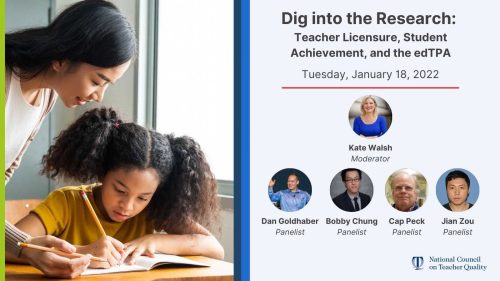School closures have obvious impacts on current students and teachers, and are also creating challenges for teacher candidates hoping to graduate this spring and enter classrooms in the fall.
As of this week, twenty-three states and three U.S. territories have either ordered or recommended statewide closures of schools until the end of the academic year in an effort to minimize contagion during the COVID-19 pandemic (up-to-date information on school closures can be found here).
States must now consider how these coronavirus-related closures are impacting student teaching and other licensure requirements.1
Student Teaching
School closures are affecting the clinical experiences of teacher candidates during the 2020 spring semester, leaving them at risk of not meeting their certification requirements. This is a catch-22 for states, which must balance incoming teacher performance requirements and their impact on students in the long run, with competing and pressing issues such as teacher shortages and the health and safety of their population during this pandemic.
Several states have already devised emergency and contingency plans to address this multifaceted dilemma. Although some states have been able to make these changes through executive processes, others require legislative action to change or temporarily waive requirements. In terms of clinical experiences and internships that are currently being cut short, states are taking two broad approaches.
The first approach, adopted by states such as California, Georgia, Kentucky, New Jersey, and New York, allows for flexibility in terms of what student teaching experiences can now look like. Non-traditional instruction, including distance learning lessons, is permitted to count for clinical experiences, and observations may be remote or through recorded video.
In California, the Commission on Teacher Credentialing allows the “it takes a village” approach by letting other experienced educators, rather than just the cooperating teacher, to work with the teacher candidates.
The second approach, adopted by states such as Alabama, Michigan, Mississippi, Missouri, South Carolina, Texas, and Vermont waives the specific length requirement of the student teaching experience. With this approach, cooperating teachers and supervisors will make an overall assessment with the information they already have on hand. Texas and Vermont have issued precise guidance in terms of how many weeks are now deemed acceptable, as well as detailed modified requirements, to successfully fulfill the clinical experience requirement.
A related approach has been adopted by Virginia and Ohio, which have not provided a blanket waiver of student teaching length and observation requirements, but instead are allowing individual teacher preparation programs to apply to waive specific student teaching requirements at their discretion.
Other Teacher Licensure Requirements
Other certification requirements have also been affected by the current closures. School closures are having a negative impact on teacher candidates’ ability to complete portfolios and performance-based assessments, such as the edTPA. The closure of testing centers is also preventing candidates from being able to sit for their required certification exams.2
Again, states are generally taking two different approaches.
The first approach, taken by states like Mississippi and New York, is to waive the requirement that teacher candidates must pass their certification exams before licensure, and instead allows teacher candidates to apply for full licenses at the discretion of their preparation programs. This means that teachers who have not passed their content exams will be allowed into the classroom for a number of years. Mississippi, in particular, is suspending the licensing testing criterion for a year and a half, thereby allowing teachers who have not passed the required tests to apply for a five-year standard license.
Teachers with strong foundations, such as content knowledge, will be crucial as the educational system recovers from the effects of this pandemic. Therefore, a stronger approach is that of granting provisional or emergency licenses. Many states, such as Alabama, Georgia, Michigan, New Mexico, and Washington, will allow teacher candidates who have completed most, but not all of their licensure requirements to obtain a one-year provisional or emergency license. Some states, like Missouri and South Carolina, are requiring verification of employment by a school district before issuing these emergency licenses.
Of the twenty-five states that require a performance assessment, the edTPA is the more widely used, and a similar pattern is observed in how states are dealing with this requirement.
New York and Iowa, for example, have waived their edTPA requirements and allowed teacher candidates to substitute them for other non-performance-based tests. However, as testing centers are currently closed, no clear guidance was found on the inability to fulfill both the performance requirement and their tests. Since New York has also waived all certification exam requirements, it could be the case that teacher candidates who have not completed either requirement will be issued full licenses.
For the group of states that are making use of provisional or emergency licenses, those which also use the edTPA (such as Alabama, Georgia, and Washington) did not require candidates to pass this performance assessment before they can start to teach, but only that they must pass it before the license expiration.
Next steps for states
States are the final gatekeeper for the teaching profession and it is their duty to ensure students are being taught by teachers who are fully prepared. Typically, we advise states against the creation of standing emergency licenses in favor of regular licenses that require the completion of all the certification requirements. However, a situation like this pandemic is exactly the scenario in which an emergency license makes more sense than granting full licenses to those who have not completed certification requirements.
There is still a group of states that has not issued guidance regarding student teaching or initial licensures in this challenging situation. These states will have to develop a strategy to support teacher candidates in these uncertain times. Additionally, all states will need to develop strategies to support their newly minted teachers and those entering with provisional licenses into the upcoming school year. In particular, those who were not able to complete their clinical experiences or meet their certification requirements, and will have to work on finalizing those requirements during their first year of teaching, will certainly require extra support in terms of induction, professional development, and mentoring not only for their own sake but also for the immediate and long-term impact on their students. NCTQ will continue to monitor these efforts.
Moving forward, states should:
- Make use of emergency licenses as opposed to issuing standard licenses to teachers who have not met the requirements. These licenses should be one-year and non-renewable licenses for teacher candidates who are unable to fulfill specific licensure requirements due to the coronavirus pandemic. Georgia, Kentucky, and Ohio are using a one-year emergency license that clearly states it is non-renewable and specifies a deadline for the completion of the missed requirements.
- Track the impact of the flexibility or waivers granted during this period to ensure that teachers with emergency licenses are not disproportionately assigned to vulnerable populations.
- Consider extra measures of support for incoming first-year and novice teachers, including additional professional development, induction, and mentoring.
Footnotes:
More like this

Dig into the Research: Teacher licensure, student achievement, and the edTPA
NCTQ President Kate Walsh hosts a panel discussion on how the edTPA affects the teaching profession with leading researchers in the field of educator preparation.

2012 State Teacher Policy Yearbook: Improving Teacher Preparation National Summary
Endnotes
- Given the rapidly changing nature of this pandemic, states continue to adapt their policies concerning the topic of this publication. The state responses documented in this blog post are valid as of the date of publication.
- On April 15th, ETS announced “Praxis at Home”, which allows teacher candidates to take the Praxis exams either at home or another secure location. Pearson, the edTPA provider, has also announced the extension of deadlines to facilitate teacher-candidates’ completion of this assessment. Upon publication of this analysis, details about the state responses to these announcements were not yet available.
